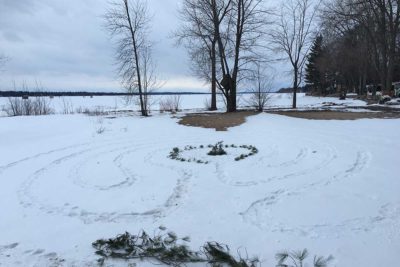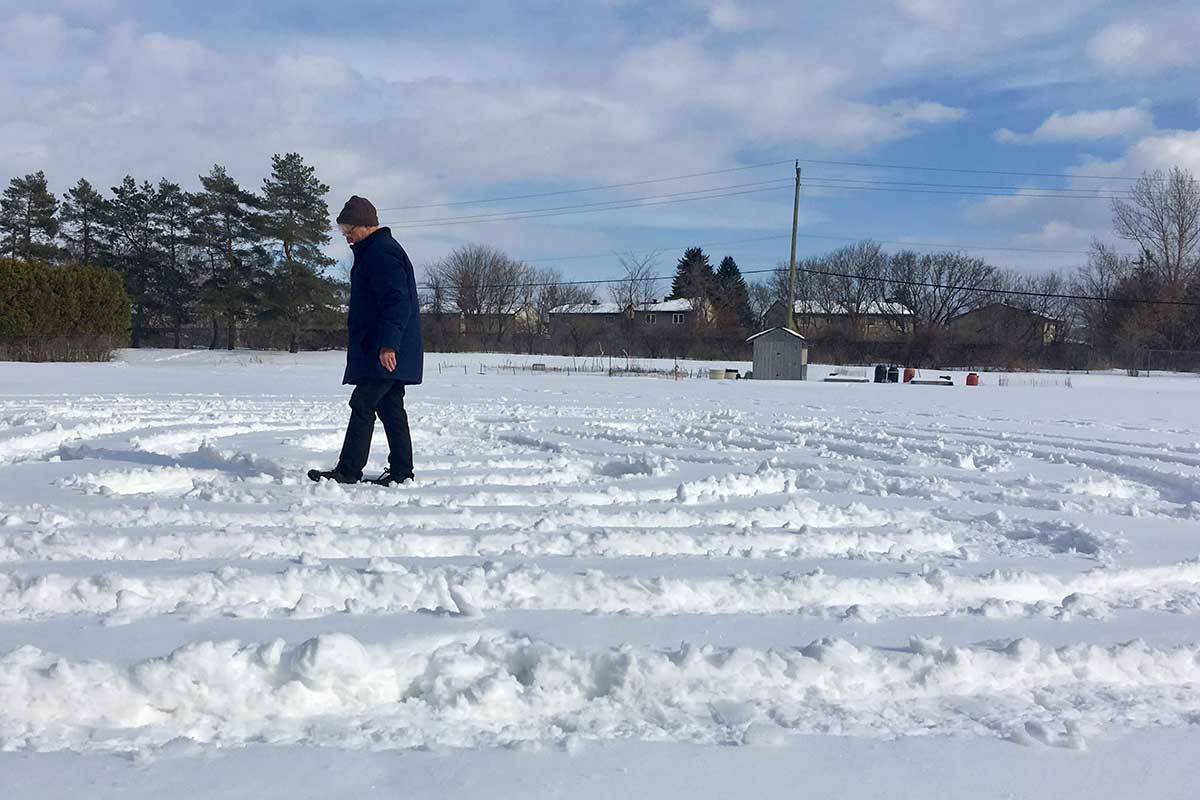Throughout the diocese, people have been finding creative ways to be the church even when they could not gather in church buildings. Like many other groups, the Cathedral Labyrinth Guild translated its programming into online gatherings when they could not access the beautiful labyrinth inlaid in the floor of the Great Hall of Christ Church Cathedral.
“Typically what people do is use a small version or a printed version of that pattern and they trace it with their finger, calling it a finger labyrinth, but what we’re doing in our programming is trying to find different ways of getting to that same quiet meditative and community place,” Barbara Brown explained when five members of the guild met with Crosstalk for an online conversation. On Dec. 22, Brown and fellow guild member Caroline Balderston Parry led a virtual online gathering to mark the winter solstice, asking attendees to prepare a candle, an orange and four cloves (a symbol of the sun and four directions), and a handful of freshly gathered evergreens. We’re “trying to weave together a kind of experience that parallels what it is like to be in a group walking the labyrinth together,” she said.
But winter presents another opportunity. “We are about to do our first snow labyrinth program.
“On Feb. 22, the Cathedral Labyrinth Guild is creating a snow labyrinth in Britannia Park. Unlike our usual labyrinths, this one will allow for social distancing; it will have a oneway path that leads into the centre, and then continues out by a different path.
“We will also host an online program on February 22 at 7 pm.”
(See the Cathedral website or Facebook Events for details).
 About Labyrinths
About Labyrinths
Labyrinths are ancient patterns found all over the world. Although the word labyrinth is used interchangeably with maze, they are not the same. The guild’s webpage explains that “Mazes are a kind of puzzle with multiple paths and decision points, and sometimes high walls. Labyrinths, by contrast, are unicursal: a single path twisting and turning through several concentric circles or circuits to arrive at a central goal, without walls or other obstructions to visibility. There are no ‘wrong turns’ in a labyrinth.”
“In the Middle Ages, monks started drawing iterations of the labyrinth that incorporated the cross, so the pattern became more complex,” Brown explains. “A labyrinth that people gravitate to is one that was laid in the floor in the year 1200 at [the Cathedral in] Chartres, France, just north of Paris. That pattern has the cruciform incorporated into it, and at the centre there is a large circle with a rose pattern, so there’s all kinds of symbology involved in the labyrinth.”
People who could not make pilgrimages sometimes walked labyrinth paths. The labyrinth at Christ Church Cathedral in Ottawa is same pattern that is in Chartres.
“People come to the Cathedral from all sorts of spiritual [backgrounds] and cultures. …. It’s a great way for people to get drawn together,” Diane Perazzo said.
Brown describes the whole labyrinth guild program as an outreach program. “While it is housed and held within the Cathedral, both the people who are part of the guild and the people who come are beyond the Cathedral community.”
We asked each of the guild members taking part in the interview to describe some of their experiences with labyrinth walking.
 Barbara Brown
Barbara Brown
I was first introduced to the labyrinth at the Lumiere festival here in Ottawa. Ruth Richardson had set up a candlelit labyrinth with paper bags on the baseball diamond in the evening. I was there with my children who were 6 and 9 at the time. I had never seen a labyrinth, didn’t know anything about it. …Ruth gave us the 30 second introduction and … walking the labyrinth, I found myself in a kind of other space, very quiet, very interior space. I came out of that experience, looked around and there were no less than 50 screaming children running the labyrinth. It really got my attention. …
My experience of a snow labyrinth is always an individual one because I am the maker. I’ve rarely stumbled on one out there in the world, but I go out with the intention of making one. I am a visual artist and my visual art practice really helps me and has given me the skills to make these labyrinths…. I’ll make a labyrinth in the snow for the aesthetic purpose of taking a photograph, so it’s that overlay of this very human pattern informed by nature but overlaid on the landscape. [My other intention] is to give over to the experience of finding your way, remembering the pattern and having that very personal interplay in a physical way with the landscape, with the weather, with the sun, with the trees, with the setting. I find labyrinth walking keeps your brain busy at a sort of perfunctory level that allows you to access a more liminal or less rational part of your brain, so that experience is always a welcome one.
 Diane Perazzo
Diane Perazzo
A few years ago, I lived in a home further south out of Ottawa where we had room in the back to make a labyrinth. We would have people come [to a gathering in February to celebrate Candlemas] and we’d have lanterns and we would do this beautiful snow labyrinth and then we would have a campfire in the woods. Oh my goodness, for me it was such a combination of community, spirituality, an opportunity to be outside during the cold months.
…Apparently, …when you walk a labyrinth, it’s a brain-balancing activity because you always turn yourself equally, as many times as you do the in and the out of the labyrinth. … I get such a sense of well-being when I have walked a labyrinth, one that’s designed in a geometrically proper way.
… My involvement with the guild is fairly recent.. Caroline happened to invite me to a self-care gathering. I think it was about two months after my dad [an Anglican minister] passed way, and I had such a release of emotion at that time. I had no idea how much I bottled up inside of me. It was incredible. I’ve never had an experience like that since, but it was such a complete letting go of so much that I had been carrying.
 Caroline Balderston Parry
Caroline Balderston Parry
Somewhere along the way, I got the idea of pausing on each of the petals of the flower shape in the middle of the Chartres model and listening for some kind of guidance or message, so now I’ve really ritualized that. I walk in a sunwise-clockwise direction. I pause on each of the petals. I do a little turnaround 360 degrees and listen to see if I have a message. I remember that and go to the next petal, so that I will get a series of affirmations of different kinds. When I am in my garden, I just turn to the four directions, so this morning I literally got “All is well” and then I went to the song, so the second direction was “Safely rest” and the third was “God is nigh” and I think the last message was “All Shall Be Well.”
…There is definitely a balancing thing that goes on. Particularly in the big 11 circuits, you lose track of where you are. You are sort of close to the centre. You can’t quite tell how long it is going to take you. You are without bearings and yet you trust that this is a single path…. You can’t get lost…. So you just trust and then you find “Oh, here am I entering the centre” and then going out the same thing “Here am I leaving.”
And in between … it’s a kind of shorthand of three or four Rs – As you stand at the mouth of the labyrinth, the gate in as it were, you remember your connection to all of creation and to whatever your spiritual orientation might be (and that comes from Matthew Fox in Creation Spirituality). When you feel like you’ve made that connection, then as you walk in you are doing the other three Rs. You are releasing anything that’s on your mind or a concern. You might be saying a prayer for a particular person, so you are thinking about them and releasing them into the circle. Or you might just be letting go of the shopping list or whatever. And when you get to the centre, you receive, you are listening for that message. So it is remember at the mouth, then release, receive, and then as you are returning … you are thinking about how you can respond to that message. What does it carry for you in the next hours or days? It is a very useful set of guideposts.
 Chris Hume
Chris Hume
(Carleton Place Community Labyrinth)
I’ve just been on an amazing and interesting journey. …
Trusting the path is kind of saying that came to me early on with one of the books that I was given about labyrinths and it is something that I just keep close to my heart… Back in 2012 walking the labyrinth up at Burnstown, I was going into it, being open-minded. Was there anything that was going to be presented to me on my walk that day? Two phrases occurred to me: Take time for creativity and… make time for creativity. It was so strong that message, I thought “Okay I will.” Shortly thereafter, I was in Montreal and I stumbled upon a mosaic artist who was teaching courses, and I started going to those courses. I am now in my dining room, which is like a mosaic studio. I have created mosaics with an ancient labyrinth in them. I have also gone into the labyrinth just asking for a visual or an image when I am in the centre and come out and done a series of sketches of mandalas that have become different forms of art. So for me, there’s a real creative process tied in with it all.

Elspeth MacEwan
I find the labyrinth powerful when it comes to grief. There are times when you are crying on the labyrinth and there are times when you are laughing and it is just so exuberant with joy, so it is the full range of emotional experiences. And there’s a child part of me when I am out doing the winter labyrinth, I am like a kid in my snow pants, but then I might be listening to Hildegard von Bingen spiritual music, so I am this old woman, an elder, and I am a child at the same time on the same path.
Winter labyrinth at Gracefield
Mystery…
a liminal space, a magical time
Walking in darkness, subtle light, the moon…
An ancient path, alive with the spirits of all who have walked here before,
and all who walk with us.
At Gracefield Camp, in the January chill, a dozen of us don our parkas and snow pants, light our hurricane lanterns, and venture out into the night, while others cozy up to the fire with their knitting and sip hot chocolate. We make our way along the edge of the forest, silent but for the sound of boots on crisp snow; it’s a familiar path, yet stark and strange. Nestled in the forest, this labyrinth is usually snow-covered during the winter months; in the summer months, it is an exquisite garden path, always delighting walkers with new blossoms and surprising visions. In the dead of winter, a map, a pair of snowshoes and an hour or so of purposeful wandering in the waning afternoon sun unveils it. To a winter labyrinth keeper, this is a spiritual exercise, a pleasant time of preparation.
Stillness now, then a cold breath of wind.
Ann was with us the last time we made this journey. We carry her light too, remember her singing, her voice thin as she was approaching that veil…
Heaviness of grief.
blanket of snow
Warmth of community,
well-worn paths of friendship.
— Elspeth MacEwan
Cathedral Labyrinth Guild


St. James, Morrisburg — Stormont Deanery